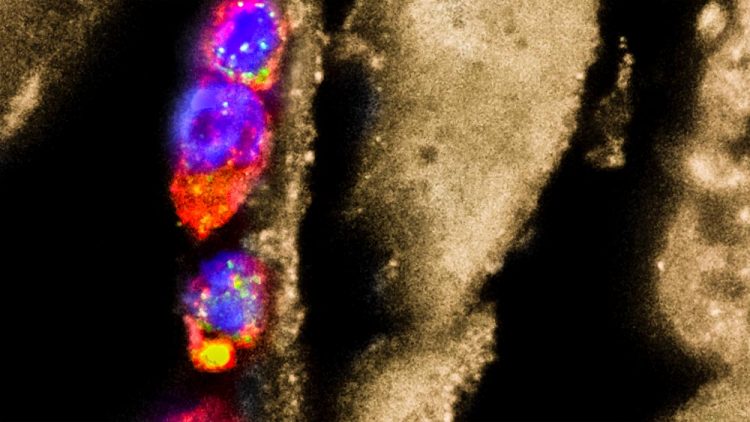New active ingredient against allergic asthma: Parasite larvae could help fight allergies

Anti-inflammatory macrophages (colored), which "sit" on parasite larvae. Image: J. Esser-von Bieren
The larvae of the roundworm Heligmosomoides polygyrus bakeri (Hpb) need a very special environment in order to survive: They have to invade the mucosal layer of the intestine in rodents, the only place where they can then develop into adult worms capable of reproduction.
To do this, the tiny larvae have to outdo the host's immune system, which defends the host against the intruders with inflammatory reactions, the secretion of fluids and muscle contractions.
“Normally the larvae of the parasitic worm would have no chance of withstanding these immune responses. But they use active molecules to specifically modulate the immune response of the host,” explains Dr. Julia Esser-von Bieren, researcher at the Center of Allergy and Environment (ZAUM) at Technical University of Munich and Helmholtz Zentrum München.
“We want to harness these evolutionarily matured active ingredients to treat chronic inflammatory diseases.”
A worm protein alters the immune response
Together with her team Esser-von Bieren has succeeded in isolating, identifying and analyzing a substance that the worm larvae use to trick the immune system of their host:
The protein Hpb glutamate dehydrogenase activates various immunoregulatory metabolic pathways. These pathways ensure the formation of anti-inflammatory mediators in the immune cells of the host organism. At the same time the number of inflammatory mediators is reduced.
“The ability of Hpb glutamate dehydrogenase to weaken the immune response makes it a promising candidate for treatment of chronic airway inflammation,” says Esser-von Bieren.
Respiratory illnesses such as allergic asthma are often the result of an over-reaction by the immune system due to an overproduction of inflammatory mediators known as leukotrienes, which can trigger asthma attacks. However, the medications currently given to patients, usually cortisone, hardly have any effect on these mediators at all.
Active ingredient for new asthma medications
The researchers used a mouse model of allergic asthma to successfully show that the larval protein can be used to suppress inflammatory reactions. Investigations using human cell cultures also provided encouraging results, says Esser-von Bieren:
“We paid particular attention to the effects on certain human immune cells known as macrophages. Constant activation of macrophages results in chronic inflammation. By adding Hpb glutamate dehydrogenase we were able to significantly reduce the pro-inflammatory activity of the macrophages. Here the substance turns out to have greater efficacy than cortisone.”
However, Esser-von Bieren points out that there is still a long way to go before a finished medication can be produced:
“We're in the pre-clinical phase and still have to address a number of questions, for example how the worm protein is received by cells in the respiratory tract and what the overall effects on the human immune system are.”
More information:
In addition to scientists from TUM and the Helmholtz Zentrum München, researchers from Goethe University Frankfurt, Germany, Karolinska Institutet Stockholm, Sweden, Friedrich-Alexander-Universität Erlangen-Nürnberg (FAU), Germany, and Monash University, Australia, also participated in the project. The project was funded by the German Research Foundation (Deutsche Forschungsgemeinschaft (DFG)), the Else Kröner-Fresenius-Stiftung foundation, the Fritz Thyssen Foundation and received Helmholtz Young Investigator Group Funding from the Helmholtz Association.
Dr. Julia Esser-von Bieren
Technical University of Munich
Center of Allergy and Environment (ZAUM)
phone: +49 89 4140 3454
julia.esser-von-bieren@tum.de
M. de los Reyes Jiménez, A. Lechner, F. Alessandrini, S. Bohnacker, S. Schindela, A. Trompette, P. Haimerl, D. Thomas, F. Henkel, A. Mourão, A. Geerlof, C. Prazeres da Costa, A. M. Chaker, B. Brüne, R. Nüsing, P.-J. Jakobsson, W. A. Nockher, M. J. Feige, M. Haslbeck, C. Ohnmacht, B. J. Marsland, D. Voehringer, N. L. Harris, C. B. Schmidt-Weber, J. Esser-von Bieren: An anti-inflammatory eicosanoid switch mediates the suppression of type-2 inflammation by helminth larval products. In: Science Translational Medicine, 22 April 2020. DOI: 10.1126/scitranslmed.aay0605
https://www.tum.de/nc/en/about-tum/news/press-releases/details/35994/
Media Contact
All latest news from the category: Health and Medicine
This subject area encompasses research and studies in the field of human medicine.
Among the wide-ranging list of topics covered here are anesthesiology, anatomy, surgery, human genetics, hygiene and environmental medicine, internal medicine, neurology, pharmacology, physiology, urology and dental medicine.
Newest articles

First-of-its-kind study uses remote sensing to monitor plastic debris in rivers and lakes
Remote sensing creates a cost-effective solution to monitoring plastic pollution. A first-of-its-kind study from researchers at the University of Minnesota Twin Cities shows how remote sensing can help monitor and…

Laser-based artificial neuron mimics nerve cell functions at lightning speed
With a processing speed a billion times faster than nature, chip-based laser neuron could help advance AI tasks such as pattern recognition and sequence prediction. Researchers have developed a laser-based…

Optimising the processing of plastic waste
Just one look in the yellow bin reveals a colourful jumble of different types of plastic. However, the purer and more uniform plastic waste is, the easier it is to…



